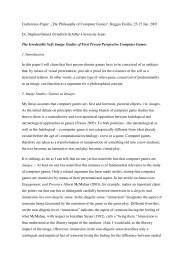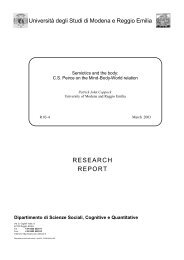Playing Dress-Up: Costumes, roleplay and imagination
Playing Dress-Up: Costumes, roleplay and imagination
Playing Dress-Up: Costumes, roleplay and imagination
You also want an ePaper? Increase the reach of your titles
YUMPU automatically turns print PDFs into web optimized ePapers that Google loves.
<strong>Playing</strong> <strong>Dress</strong>-<strong>Up</strong> Ludica<br />
When we step through the screen into virtual communities, we reconstruct our identities on the<br />
other side of the looking glass.<br />
Sherry Turkle, Life on the Screen (1995)<br />
Overview<br />
In this paper, we discuss the importance of dress-up play, as both a formative childhood play pattern, <strong>and</strong><br />
a growing <strong>and</strong> increasingly important form of adult play, in both physical <strong>and</strong> digital cultural practices.<br />
With a few notable exceptions, dress-up play has scarcely been acknowledged, let alone explored within<br />
the rubric of game studies, even though it is a growing dimension of digital games. Even pre-digital<br />
scholars of play have all but ignored this vital play form. Johan Huizinga’s now-classic exhaustive study<br />
of the play element in culture, Homo Ludens, is primarily concerned with domains of play <strong>and</strong> culture<br />
dominated by males—sports, competition, warfare, legal <strong>and</strong> political structures, etc. In one section he<br />
describes the use of costumes in the context of ritual, where they helped bring the wearer into a playful<br />
state of …<br />
….Dionysian ecstasy <strong>and</strong> dithyrambic rapture. The player, withdrawn from the ordinary world by the<br />
mask he wore, felt himself transformed into another ego which he did not so much represent as<br />
incarnate <strong>and</strong> actualize. (Huizinga, p.145)<br />
This is a fitting description of the modern concept of the “avatar,” a term based on the Sanscrit word for a<br />
god’s embodiment on Earth, <strong>and</strong> adapted by Chip Morningstar to reference a player’s representation in a<br />
multiplayer world. (Damer 1998, pp.484-485) Huizinga sees the “…almost instinctive, spontaneous need<br />
to decorate things…” (presumably this includes oneself) as constituting a “play-function.” Ironically, he<br />
describes fashion as primarily a male domain of play, reaching its height during the Baroque period <strong>and</strong><br />
exemplified by the periwig, which, he asserts, was then appropriated by women. (p.183) He follows this<br />
by describing the return to a more naturalist orientation indicated by the reappearance in portraiture of the<br />
19 th Century of men with natural, long hair. (p. 184) Outside of the context of ritual, Huizinga apparently<br />
sees fashion as a predominately male enterprise. In fact, he makes no mention of female dress-up play<br />
throughout his exhaustive study.<br />
While certainly progressing the cause of girls’ play further than Huizinga, Caillois sets the stage for a<br />
somewhat skewed vision of female play culture. After enumerating a litany of exciting roles that boys<br />
may play, from policeman, to cowboy, to aviator, to jockey, girls are relegated to the <strong>roleplay</strong> of<br />
motherhood afforded by dolls. (Caillois 1958, p. 62). In the literature of both analog <strong>and</strong> digital play, in<br />
fact, very little is written about costume play, even in the sphere of child development. Developmental<br />
scholar Jean Piaget makes only brief <strong>and</strong> passing mention to it in the context of “make-believe” play<br />
among children. (Piaget 1951) Although Sutton-Smith devotes an entire chapter to Rhetorics of Identity<br />
in play, he alludes only briefly to costume-play in the context of festivals (although he never explicitly<br />
calls it out by name), <strong>and</strong> to fashion not at all. (Sutton-Smith 1997, pp.91-110)<br />
More fruitful is the work of his fellow anthropologists in the study of ritual <strong>and</strong> performance, which we<br />
will discuss in more detail shortly, that addresses some of the complexities of <strong>roleplay</strong> in the context of<br />
ritual <strong>and</strong> theater (Turner, Van Gennep, Bell, Schechner, etc.), as well as research in the sociology of<br />
fashion, which also has bearing on this subject. In this paper, we will argue that dress-up is a central play<br />
pattern that has deep roots in human culture, <strong>and</strong> which, with the rise of multiplayer digital games <strong>and</strong><br />
virtual worlds, is playing an increasingly prominent role in both digital <strong>and</strong> non-digital play practices.<br />
One reason for these oversights may lie in the preoccupation among game scholars of what Caillois<br />
defined as “ludus” over “paidia” play activities. Caillois defines these terms on a continuum:<br />
Philosophy of Computer Games 2007 Page 2






